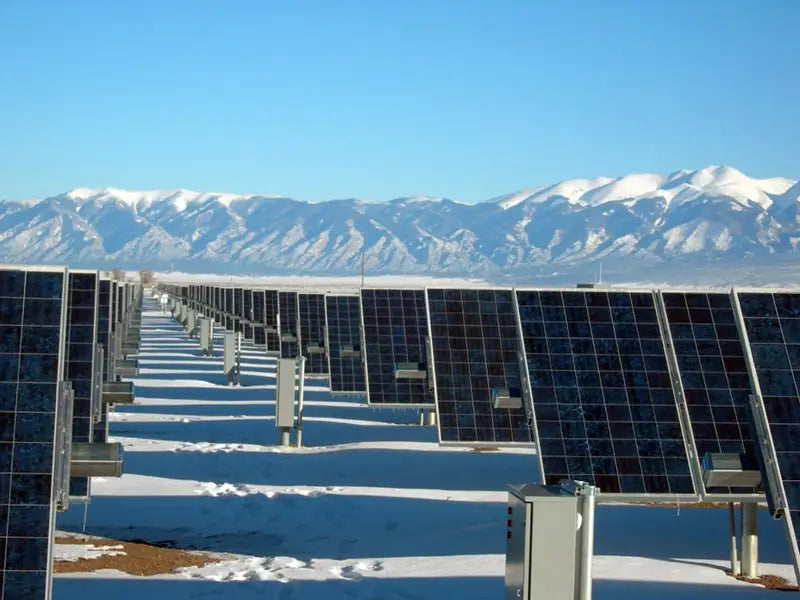
Main content:
- Solar cell array for solar photovoltaic power generation
- Silicon solar cells for solar photovoltaic power generation
- Types of Silicon Solar Cells for Solar Photovoltaic Power Generation
- Solar cell modules for solar photovoltaic power generation
- Anti-reverse charge diodes for solar photovoltaic power generation
- Battery pack for solar photovoltaic power generation
- Charge and discharge controller for solar photovoltaic power generation
- Inverter for solar photovoltaic power generation
- Measuring equipment for solar photovoltaic power generation
Solar photovoltaic power generation refers to a power generation method that directly converts sunlight energy into electrical energy without going through a thermodynamic process. It includes photovoltaic power generation, photochemical power generation, light induction power generation and photobiopower generation. Solar photovoltaic power generation is a direct power generation method that uses semiconductor electronic devices such as solar cells to effectively absorb solar radiation energy and convert it into electrical energy. It is the mainstream of solar power generation today. Nowadays, people usually refer to solar photovoltaic power generation as solar photovoltaic power generation.
Since the solar photovoltaic power generation system is made by using the photovoltaic effect, it uses solar cells to directly convert solar energy into electrical energy, so it is called a solar cell power generation system. It consists of solar cell array, controller, battery pack, DC-AC inverter and other parts. The system composition is shown in the figure below.
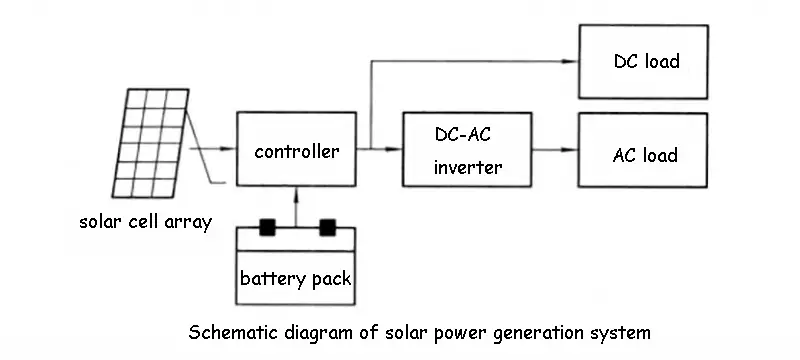
1. Solar cell array for solar photovoltaic power generation
The battery cell of solar photovoltaic power generation is the smallest unit used for photoelectric conversion. After the battery cell of solar photovoltaic power generation is connected in series, parallel and packaged, it becomes the battery module of solar photovoltaic power generation, and its power is generally several watts to tens of watts. , more than 100 watts, is the smallest unit that can be used alone as a power supply. The battery components of solar photovoltaic power generation are connected in series, in parallel and installed on the bracket to form a solar cell array, which can meet the output power required by the load. The cells, components and square arrays of solar photovoltaic power generation cells are shown in the figure below.
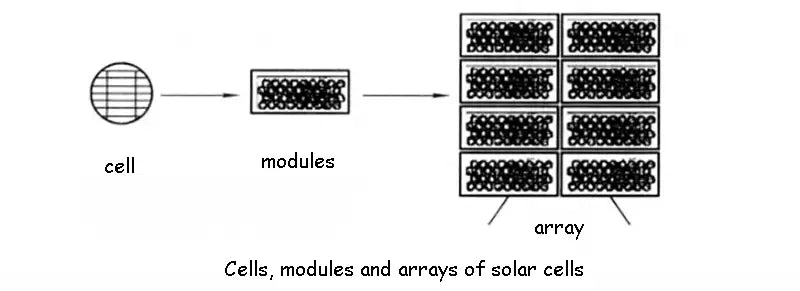
1.1 Silicon solar cells for solar photovoltaic power generation
The commonly used solar photovoltaic cells are mainly silicon solar cells. The crystalline silicon solar cell consists of a crystalline silicon wafer, the upper surface of the crystalline silicon wafer is closely arranged with metal grid lines, and the lower surface is a metal layer. The silicon wafer itself is P-type silicon, the surface diffusion layer is the N region, and the junction between these two regions is the so-called PN junction. The PN junction forms an electric field. The top of the solar cell is covered with an anti-reflection film to reduce the reflection loss of solar energy. Light is composed of photons, and photons are particles containing a certain amount of energy, and the amount of energy is determined by the wavelength of light. After the light is absorbed by the crystalline silicon, a pair of positive and negative charges are generated in the PN junction. Since the positive and negative charges in the PN junction area are separated, an external current field is generated, and the current flows from the crystalline silicon wafer cell. The bottom end flows through the load to the top end of the battery.
When a load is connected between the upper and lower surfaces of the solar cell, a current will flow through the load, and the solar cell will generate current. The more photons absorbed by the solar cell, the greater the current generated. The energy of photons is determined by the wavelength. Photons with lower energy than base energy cannot generate free electrons, and a photon with energy higher than base energy only generates 1 free electron. , the excess energy will cause the battery to heat up, and the effect of the accompanying power loss will reduce the efficiency of the solar cell.
1.2 Types of Silicon Solar Cells for Solar Photovoltaic Power Generation
At present, there are three commercialized silicon solar cells for solar photovoltaic power generation in the world, namely monocrystalline silicon solar cells, polycrystalline silicon solar cells and amorphous silicon solar cells. Since the monocrystalline silicon material used in monocrystalline silicon solar cells has the same quality as that used in the semiconductor industry, the material cost is relatively expensive. The irregularity of the direction of the polycrystalline silicon solar cell body means that the positive and negative charge pairs cannot be completely separated by the PN junction electric field. Polycrystalline silicon solar cells are generally somewhat less efficient than monocrystalline silicon solar cells because charge pairs may be lost at crystal-to-crystal boundaries due to crystal irregularities. But multi-product silicon solar cells can be produced by casting, so its cost is lower than that of monocrystalline silicon solar cells. Amorphous silicon solar cells are thin-film cells with low cost, but their photoelectric conversion efficiency is relatively low, and the stability is not as good as that of crystalline silicon solar cells.
1.3 Solar cell modules for solar photovoltaic power generation
(1) Package type. The reliability of solar photovoltaic power generation cells depends to a large extent on its anti-corrosion, wind-proof, hail-proof, rain-proof and other capabilities, and the potential quality problems are the sealing effect of the edge and the quality of the junction box on the back of the module.
(2) Electrical characteristics. The electrical characteristics of solar photovoltaic power generation cell components mainly refer to the current-voltage characteristics, also known as the I-U curve, as shown in the figure below. The I-U curve shows the relationship between the current delivered through the solar cell module and the voltage at a specific solar irradiance.
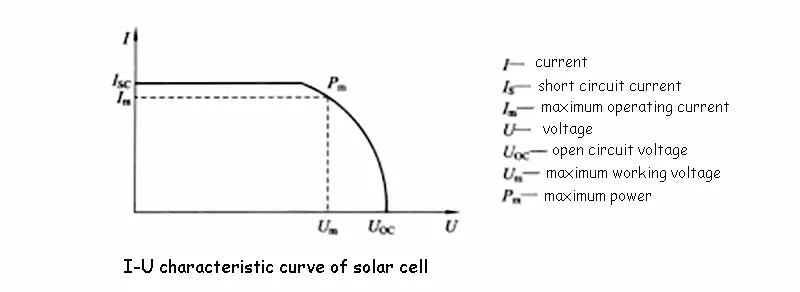
(3) Performance test. Since the output power of a solar photovoltaic power generation cell module depends on the solar irradiance, the distribution of the solar spectrum and the temperature of the solar cell, the measurement of the solar photovoltaic power generation cell module must be carried out under standard conditions, which are defined by the "European Commission" as Standard No. 101, the conditions are: spectral irradiance: 1000 W/m2; spectrum: AM 1.5; battery temperature: 25°C.
Under this condition, the maximum power output by the solar photovoltaic power generation cell module is called peak power, and its unit is watts. In many cases, the peak power of a module is usually measured with a solar simulator and compared to standardized solar cells from international certification bodies.
Measuring the peak power of solar photovoltaic modules outdoors is difficult because the actual spectrum of sunlight received by the solar modules depends on atmospheric conditions and the position of the sun. In addition, the temperature of the solar photovoltaic cells was constantly changing during the measurement. The error in outdoor measurements can easily reach 10% or more.
(4) Hot spot effect and bypass diode. Under certain conditions, the shaded solar cell modules in a series branch will be used as loads to consume the energy generated by other illuminated solar photovoltaic power generation cell modules. The shaded solar cell modules will heat up at this time, which is the hot spot effect. This effect can severely damage solar cells. Some or all of the energy produced by a solar photovoltaic cell that is illuminated may be consumed by a shaded cell. In order to prevent the solar cell from being damaged due to the hot spot effect, a bypass diode needs to be connected in parallel between the positive and negative poles of the solar photovoltaic power generation cell module to prevent the energy generated by the illuminated module from being consumed by the shaded module.

(5) Connection box. The junction box is a very important component, and its function is to protect the interface between the battery and the outside world, as well as the wires and other system components connected inside each component. The junction box contains 1 junction box and 1 or 2 bypass diodes.
(6) Reliability and service life of solar photovoltaic power generation cells. The best way to check the reliability of solar photovoltaic power generation modules is to conduct field tests. But this test takes a long time. In order to measure the reliability of solar photovoltaic power generation cells in a shorter time under similar working conditions at a lower cost, a new test method is being developed, that is, a test method for accelerated service life. This test method is mainly designed based on the correlation between field tests and accelerated tests performed in the past, based on theoretical analysis and with reference to other electronic measurement techniques and the test standards of the International Electrotechnical Commission (IFC).
A complete set of reliability test methods are described in the IEC specification. This specification includes the following tests: UV lighting test, high temperature exposure test, high temperature-high humidity test, frame twist test, mechanical strength test, hail test and temperature cycle test. For the solar photovoltaic power generation cell components in the solar cell power generation system, its expected service life is at least 20 years. The actual service life depends on the structural performance of the solar photovoltaic power generation cell components and the local environmental conditions of installation
(7) Solar photovoltaic power generation cell components in special application fields. In some practical applications of solar photovoltaic power generation, smaller solar cell modules than standard modules with peak power of 36W~55W are required. For this purpose, solar photovoltaic power generation cell modules can be produced as modules with the same number of cells, but with a smaller cell area. For example, a solar photovoltaic power generation cell module packaged by 36 5 cm × 5 cm cells has an output power of 20W and a voltage of 16V.
The solar photovoltaic power generation cell components used in the ocean should adopt special design methods and processes to withstand the erosion of sea water and sea wind. In such a solar photovoltaic power generation cell module, it has a metal plate on the back to resist tsunami shock and seagull attack, and all materials in the module must have high corrosion resistance.
In hazardous areas, solar photovoltaic power generation cell components should use special exterior protection panels. In addition, the solar cell module must be able to be connected with other equipment as a unified whole.
2. Anti-reverse charge diodes for solar photovoltaic power generation
Anti-reverse charging diodes, also known as blocking diodes, are used to prevent the battery pack from discharging through the solar cell array when the solar photovoltaic power generation cell array does not generate electricity in rainy days and nights or when a short circuit fault occurs. The anti-reverse charging diode is connected in series in the square array circuit of the solar photovoltaic power generation cell, and plays the role of unidirectional conduction. It must be able to withstand a large enough current with a small forward voltage drop and a small reverse saturation current. Generally, a suitable rectifier diode can be selected as the anti-reverse charging diode.
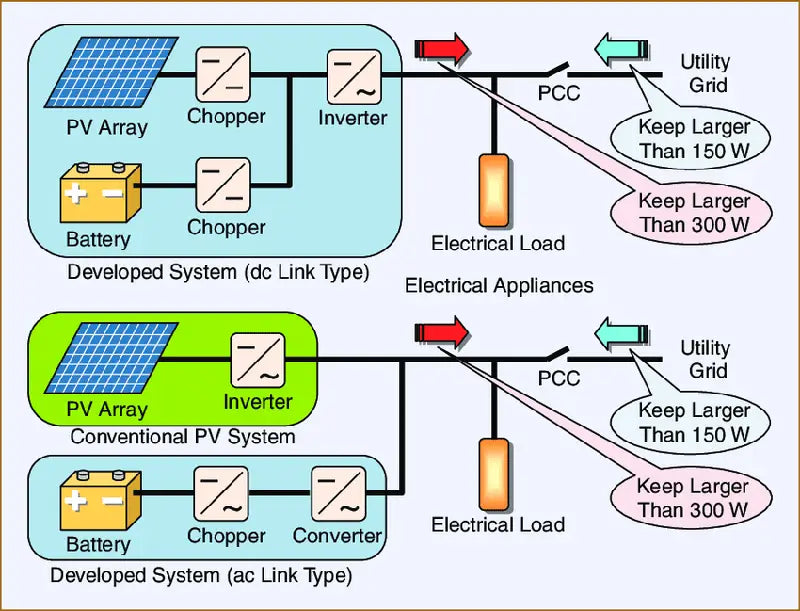
3. Battery pack for solar photovoltaic power generation
The role of the battery pack is to store the electrical energy generated by the solar photovoltaic power generation cell array when it is illuminated, and to supply power to the load at any time. The basic requirements of the solar photovoltaic power generation battery power generation system for the battery pack used are: low self-discharge rate, long service life, deep Strong discharge capacity, high charging efficiency, low maintenance or maintenance free, wide temperature range and low price.
4. Charge and discharge controller for solar photovoltaic power generation
The charge and discharge controller is a device that can automatically prevent overcharge and overdischarge of the battery pack, and generally has a simple measurement function. After the battery pack is overcharged or overdischarged, its performance and life will be seriously affected, so the charge and discharge controller is generally indispensable. The charge-discharge controller can be divided into series control type and shunt control type according to the position of its switching device in the circuit; according to its control method, it can be divided into switch control type and pulse width modulation control type. The switching device can be a relay or a MOS transistor. However, the pulse width modulation controller can only use MOS transistors as switching devices.
5. Inverter for solar photovoltaic power generation
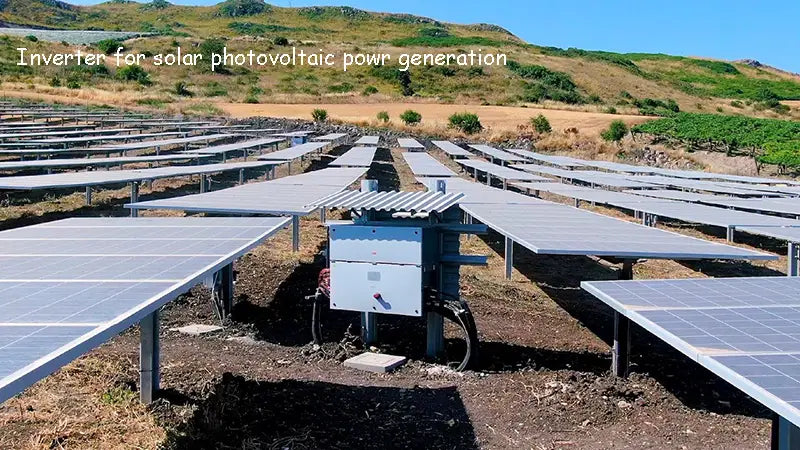
The inverter of solar photovoltaic power generation is a device that converts direct current into alternating current. Since the solar photovoltaic power generation cell and battery emit direct current, the inverter is indispensable when applied to an alternating current load. According to the operation mode, inverters can be divided into independent operation inverters and grid-connected inverters. The independent operation inverter is used for the independent operation of the solar photovoltaic power generation battery power generation system, which can supply power to the independent load; the grid-connected inverter is used for the grid-connected operation of the solar photovoltaic power generation system, which can feed the generated electric energy into the grid. The inverter can be divided into square wave inverter and sine wave inverter according to the output waveform. The circuit of square wave inverter is simple and the cost is low, but the harmonic component is large, and it is generally used in systems with less than a few hundred watts and low harmonic requirements; sine wave inverter has high cost but can be applied to various loads . In the long run, transistor sine wave inverters will become the mainstream of solar power inverter development.
6. Measuring equipment for solar photovoltaic power generation
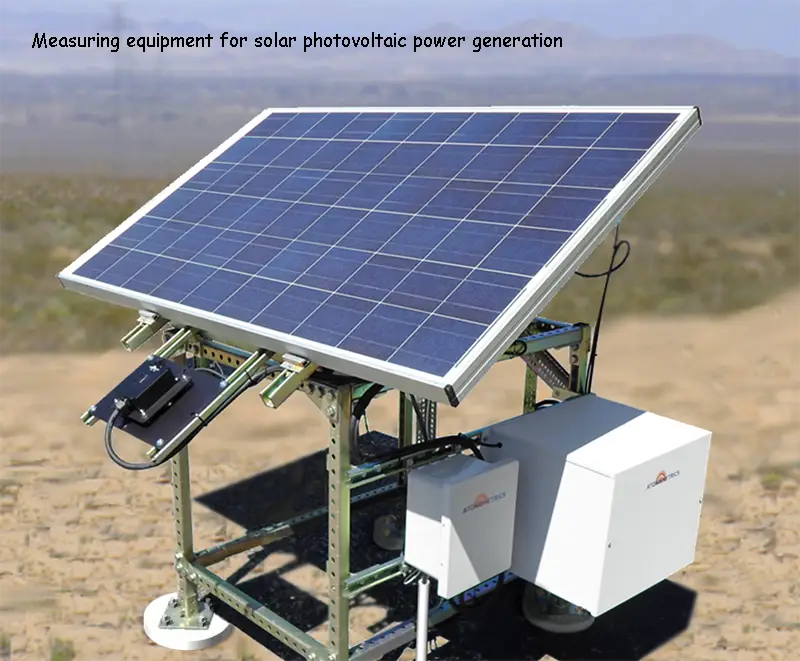
For small solar photovoltaic power generation systems, generally only simple measurements are required, such as measuring battery voltage and charging and discharging current. At this time, the voltmeter and ammeter used for measurement are generally installed on the controller. For industrial power systems such as solar communication power systems, pipeline cathodic protection systems and large-scale solar photovoltaic power stations, more parameters are often required to be measured, such as measuring solar radiation energy, ambient temperature, charge and discharge power, etc., and sometimes even require Remote data transmission, data printing and remote control functions. In order to carry out this more complex measurement, it is necessary to equip the solar photovoltaic power generation system with a data acquisition system and a microcomputer monitoring system.
Read more: Introduction of solar battery array